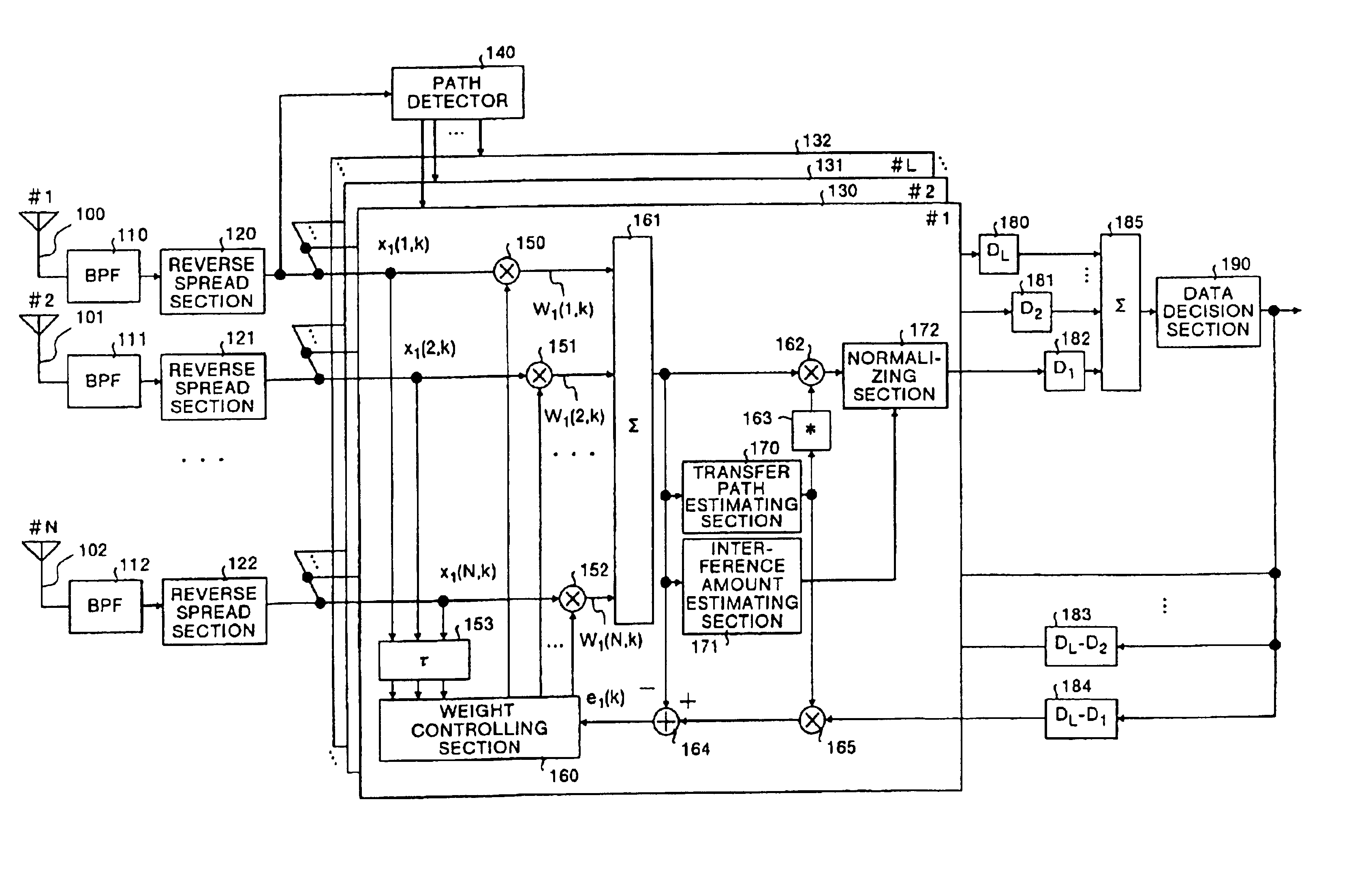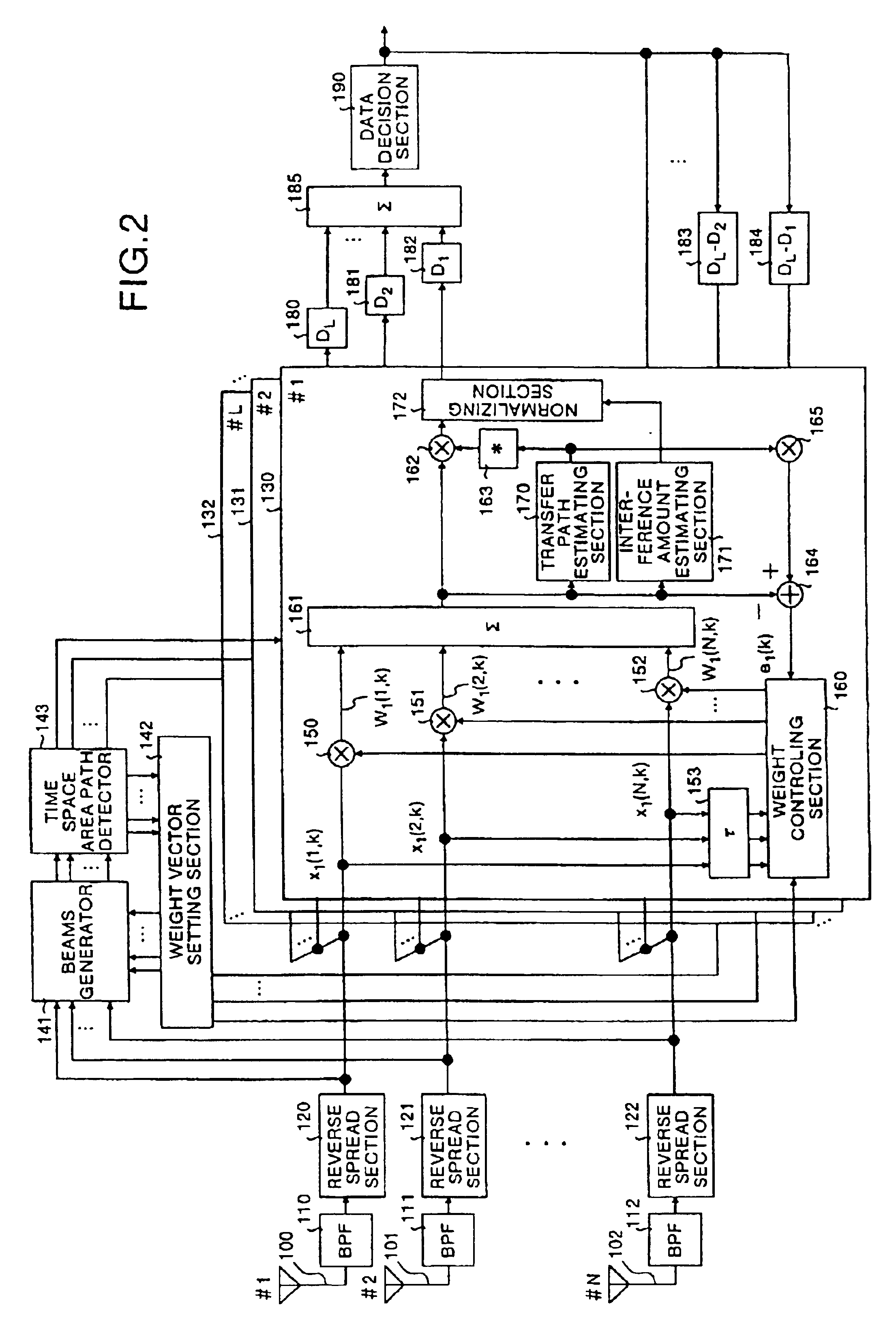Spread spectrum receiving apparatus
a spectrum receiving and spectrum technology, applied in diversity/multi-antenna systems, multiplex communication, polarisation/directional diversity, etc., can solve the problems of difficult for the base station to direct beams to the mobile station with high precision, and it is difficult to detect paths with high precision
- Summary
- Abstract
- Description
- Claims
- Application Information
AI Technical Summary
Benefits of technology
Problems solved by technology
Method used
Image
Examples
first embodiment
[0042]The first embodiment is related to a spectrum spread receiver in which an adaptive array antenna is used. FIG. 1 shows the construction of a spectrum spread receiver in accordance with the first embodiment. In FIG. 1, reference numerals 100, 101, . . . , 102 are antennas the number of which is represented by N (a natural number); 110, 111, . . . , 112 are band-pass filters (BPFs); 120, 121, . . . , 122 are reverse spread sections; 130, 131, . . . , 132 are beam forming sections for individually forming beams based upon L (a natural number) paths generated by signals that have been subjected to the reverse spread under an influence of a multi-path wave; 140 is a path detector; 150, 151, . . . , 152 are complex multipliers; 153 is a delay unit; 160 is a weight controlling section; 161 is an adder; 162 is a complex multiplier; 163 is a complex conjugate calculator; 164 is a substracter; 165 is a complex multiplier; 170 is a transfer path estimating section for estimating a transf...
second embodiment
[0062]In the same manner as the first embodiment, the second embodiment carries out calculations of weights based upon an adaptive algorithm such as LMS; however, it is also characterized by carrying out an integral process in which a weighting process is applied to the error signal e1(k). Here, those parts that are the same as those shown in FIG. 1 of the first embodiment are indicated by the same reference numerals, and the description thereof is omitted. Therefore, the following description will discuss the operation of the weight controlling section 160.
[0063]First, the weight controlling section 160 receives the error signal e1(k) from the subtracter, and carries out an integral process on the error signal e1(k) by using a weighting coefficient λ.
E1(k+1)=E1(k)+λ·e1(k) (4)
[0064]λ is a weighting coefficient (01(k) is a complex number value. The complex number value E1 (k) is E1 (0)=0.
[0065]Then, the weight controlling section 160 updates / determines the weight in accordance with ...
third embodiment
[0068]In the same manner as the first embodiment, the third embodiment will discuss a spectrum spread receiver in which adaptive array antennas are used. FIG. 2 shows the construction of the second embodiment of a spectrum spread receiver in accordance with the present invention. Here, those parts that are the same as those shown in the first or second embodiment are indicated by the same reference numerals, and the description thereof is omitted.
[0069]In FIG. 2, reference numerals 130, 131, . . . , 132 are beam forming sections for individually forming beams based upon L-number (natural number) of paths generated by signals that have been subjected to the reverse spreading process under an influence of multi-path waves, reference numeral 141 is a beams generator, 142 is a weight vector setting section, and 143 is a time space area path detector.
[0070]Next, an explanation will be given of the operation of the spectrum spread receiver having the above-mentioned arrangement. With resp...
PUM
 Login to View More
Login to View More Abstract
Description
Claims
Application Information
 Login to View More
Login to View More - R&D
- Intellectual Property
- Life Sciences
- Materials
- Tech Scout
- Unparalleled Data Quality
- Higher Quality Content
- 60% Fewer Hallucinations
Browse by: Latest US Patents, China's latest patents, Technical Efficacy Thesaurus, Application Domain, Technology Topic, Popular Technical Reports.
© 2025 PatSnap. All rights reserved.Legal|Privacy policy|Modern Slavery Act Transparency Statement|Sitemap|About US| Contact US: help@patsnap.com



